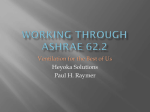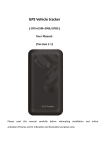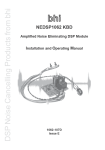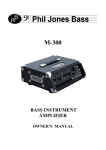Download Product User`s Manual
Transcript
TD-17 TRANSMITTER DETECTOR INSTRUCTION MANUAL ABOUT THE TD-17 Size: 4.25@ x 2.5@ x 1.75@ Weight: 7 oz. Battery: 9 volt transistor type B Eveready 216. Frequency Response: Covers 1 MHz to 1,000 MHz. Most sensitive over the 30 to 170 MHz range. (This is where most of the bugs are.) Sensitivity: Xmtr Power* Detection Range 25 mW 12 ft. 50 mW 24 ft 100 mW 36 ft. Antenna: Telescoping whip B extends to 33@ Indicators: RF ALERT B LED comes in on the presence of an RF field that exceeds the threshold level. This level may be set by internal adjustment. RANGE B LED normally flashes about once per second. As the intensity of the RF field increases, the flash rate will increase. Audio B An audible Aclick@ will be heard in step with the RANGE LED. The audio level was purposely kept low to avoid alerting the bugger that you are looking for his device. The Aclick@ can also be felt through the case by most people. Controls: SENSITIVITY B In addition to acting as the on/off switch, this control can be used to electronically vary the sensitivity over a 40 dB range. THRESHOLD B Internal adjustment (accessible through the case without removing the cover) used to set the level at which RF ALERT will come on. A plastic adjustment tool is included. GETTING STARTED If the battery has not already been installed, go ahead and install one now. Use an Eveready 216 for normal use or an Eveready 522 (alkaline) for heavy use. The battery compartment is accessed by sliding open the compartment cover located on the bottom end of the unit. Connect the battery to the battery snap and reinstall the cover. Leaving the antenna telescoped into the case, turn the SENSITIVTY control clockwise just until the unit comes on. The RANGE LED will come on for about two seconds while 1 the circuit performs a self-check. It will then begin flashing about once per second. A Aclick@ should also be heard in step with the flashing. The RF ALERT LED should be off at this time. If it is on, the THRESHOLD is too low and should be adjusted. This adjustment can be made through the access hole in the face plate using the plastic tool that is provided. Turn the adjustment until the RF ALERT just goes off. This is the most sensitive setting for this adjustment and will give the greatest detection range for the TD-17. The THRESHOLD adjustment sets the Afloor@, below which, an RF signal will not be detected. If you are using the TD-17 in a high RF area, you may want to raise the THRESHOLD somewhat above its most sensitive setting. The plastic tool can be stored in the battery compartment for easy access. From the previous discussion, we don=t mean to imply that you will have to adjust the THRESHOLD level. It has been set at the factory and will probably not require adjustment. But, if for some reason, you need to make the adjustment, you=ll know how to do so. Now, extend the antenna to its full length and turn the SENSITIVITY to maximum. The TD-17 is now ready to use. For best results, the antenna should always be fully extended when making a sweep. FINDING BUGS WITH THE TD-17 This section is not meant as a complete course on finding bugs, but it will give you some idea of where to start and how to use the unit. We=ll be covering three main areas: the home or office, telephones, and vehicles. HOME or OFFICE Transmitters are frequently concealed in various household or office fixtures. The most common are electric sockets or cube taps. In this configuration, normal AC power is supplied directly to the transmitter which permits permanent installation. This means that all lamps and appliances (radio, TV, clock, desk calculator, etc) should be checked carefully. Another type is the drop transmitter. These are used where quick installation is required. Being battery operated, they have a finite operating life which requires that they be retrieved for battery replacement or abandoned. These transmitters are often preconcealed in objects such as picture frames, pens, desk sets, cigarette lighters and ash trays. Body transmitters are battery operated, usually with a higher output power than the drop transmitter. They are designed to be carried into a target area on a person. 2 In using the TD-17 to find a planted transmitter, turn the unit to maximum sensitivity and extend the antenna fully. If you are in an area of high ambient RF (from radio or TV transmitters) you may have to set the sensitivity for less than maximum. Walk slowly around the room while sweeping the TD-17 (antenna) slowly up and down from ceiling to floor. Also, turn on the various lamps and appliances as you come to them to activate any bugs that may be wired in. When an RF field over the threshold level is detected, the RF ALERT will come on. At this time, sweep the TD-17 slowly from side to side to get a bearing on the transmitter direction. If you get confusing indications from reflecting or multi-path, reduce the SENSITIVITY some and continue sweeping. As you approach the transmitter, the RANGE LED will flash faster. By sweeping the TD-17 and observing the RANGE indicator, you should be able to home in on the transmitter quickly. If the RF ALERT comes on, but the RANGE does not flash, you are probably receiving a legitimate radio or TV station. In detecting a body transmitter, your subject would obviously become suspicious if you started waving the TD-17 in his face. So the thing to do in a situation where a body transmitter might be present is to set up the unit ahead of time in a discrete place that you or an assistant can observe. If the RF ALERT comes on when the subject walks into the room, you will know he or she is carrying a transmitter. TELEPHONE The telephone is subject to many different eavesdropping attacks. Probably the best policy is to not say anything over the phone that you don=t want the whole world to know about. And never say anything of a confidential nature over a cordless phone. Two basic types of radio bugs are available that will transmit both sides of a telephone conversation. The series tap is installed in series with the phone lines and draws its power from the phone line. It can be installed inside the phone or anywhere along the line. The parallel tap is placed across the line at any point or inside the telephone. It is usually battery powered with the attendant limitations of battery powered bugs. Both types can use the phone lines as an antenna or can have a separate antenna. Both are generally activated when the phone is taken off-hook. To detect phone bugs with the TD-17, set the unit to maximum sensitivity and fully extend the antenna. Place a call with the phone. (If you=ll dial the phone=s own number, you=ll get a busy signal which can activate a VOX type bug.) Then, sweep around the phone and its lines while watching the RF ALERT LED. If the LED comes on, hang up the phone. If it then goes off, that is an indication of a phone bug. You would then repeat the sequence to home in on the bug=s location, 3 VEHICLES While voice bugs can be installed in a vehicle, probably the most common type is the tracking transmitter (bumper beeper). Most of these are the burst type which means that RF is transmitted in short bursts rather than continuously. These transmitters can be powered either by their own battery pack or by the vehicle battery. The ones powered by the vehicle battery can have a much higher output power and, of course, a longer useful life. The main advantage of the battery pack unit is that it is quicker to attach. To check a vehicle for bugs, turn the ignition on, but don=t start the engine. (Ignition noise will confuse the TD-17). Sweep around, under, and inside the vehicle with the TD-17. Because of the limited brightness of the indicator LEDs, it would be better to do this away from direct sunlight, if possible. Pay particular attention to the RF ALERT LED. Brief flashes could indicate a bumper beeper. SUMMARY & LIMITATIONS The best way to become proficient with the TD-17 is to practice. A reasonable and readily available practice transmitter is a child=s 49 MHz walkie-talkie sold at Radio Shack for $10 to $20 depending on the model. For the most effective practice, get someone to hide the transmitter for you. The person hiding the transmitter should be reasonable. As a practical matter, a spy is not going to hide a transmitter inside a refrigerator or metal file cabinet. All that steel would cut down on the radiated signal. Just tape down the transmit button, turn the unit on and have someone hide it. Then practice finding the transmitter using the TD-17. The TD-17 is not meant to be a substitute for a sophisticated countermeasures receiver or spectrum analyzer. It will not detect some of the very low power transmitters. The TD-17 will probably not work well in a high RF environment such as midtown Manhattan, because the THRESHOLD level would have to be set too high. But, with careful use, and a realization of its limitations, it can prove to be a very useful countermeasures tool. 4








